“At 11:30 a.m. she came in, hugged everybody and said she wanted to go to the beach. At 1:30 p.m., she drowned". Just like that, with those words, Jim MacKenzie narrated Kattia María Umaña Chaverri's death, which took place on January 25th. The lack of warning signs on dangerous beach areas put the life of three teenagers at risk, killing their mother. (click here to see the article in the Jan 2010 archive)
MacKenzie lives in Guiones and employs Cristian Caravaca, Umaña Chaverri's husband, as a full-time nurse. Caravaca narrated, a month after his wife's death, that he "is still in shock".
Safe and Unsafe Areas Guiones

According to official statistics from the Red Cross, between 2001 and 2009, 54 deaths were caused by submersion (drowning) in Guanacaste and, during this time, they responded to 25 water-related accidents in Nosara and 25 in Samara, out of which an unknown number of deaths resulted.
AQUATIC ACCIDENTS ATTENDED BY THE RED CROSS

If we consider that in Playa Jacó, one of the main tourist destinations in the country, they had to intervene in 237 accidents, both Nosara and Samara seem to be pretty "safe" beaches.
According to surfing photographer, James Rees, during high season -December through April- Playa Guiones gets a daily average of 70 people in the water, including surfers and swimmers. Over Christmas and Holy Week, this number goes up to 200 people. Rees has photographed Guiones each morning since 2008.

Safe and Unsafe Areas Guiones
In turn, Charlie Foerester of C&C Surf School in Playa Samara, mentioned that this beach gets an average of 100 swimmers per day and, during Christmas and Holy Week, it can receive over 300 swimmers per day.
As the number of tourists grows, the chances of having accidents increase and, with the promise of a paved road between Samara and Nosara, there is every indication that a larger number of visitors will soon be a reality.
Training vs. Experience
Superficial and underground currents exist in every ocean. Several arrive to Playa Guiones, Pelada and Sámara and one must get to know them well before heading out to surf or swim (see graph "Safe and Unsafe Areas").
Among the most common causes that trigger water accidents are: excessive confidence -"I know how to swim"-, parents who are careless with their children, alcohol intake and a lack of information, such as the lack of warning signs that indicate which are the dangerous areas.
In almost every surf school in Nosara and Samara, instructors have received water rescue training and are certified in CPR (cardiopulmonary resuscitation) and first aid however, they lack the experience of lifesavers. "It is definitely necessary", explained Esteban López Paniagua, a Nosara instructor. “Having lifeguards will help us in any situation, we are constantly in the water and you can never tell when (the lifeguard's service) may be needed", he added.
Like López, instructor Didier Castillo from Sámara agrees. "Costa Rican beaches need to be watched by professional lifeguards. Even though I have experience in the ocean, I would be very happy to have somebody who will take care of a situation", Castillo mentioned.
Number of people who died by accidental death in Costa Rica
Asfixiation by submersion, Official data from Poder Judicial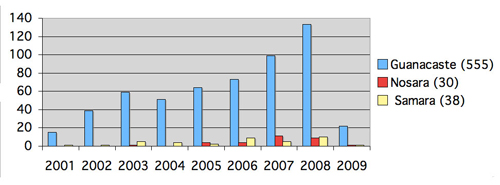
The Economic Costs are a Big Obstacle
Luis Hidalgo, president of the Asociación Nacional de Guardacostas de Costa Rica (National Lifeguard Association of Costa Rica), explained that “it would be ideal to have a lifeguard stand with two lifeguards within every 200 meters but, since the whole beach does not have visitors all year long, (the area covered) should be the main area”.
According to Randall Cortez, vice president of the Nosara Tourism Chamber, the costs of having a lifeguard service are high. “I have consulted this with the Red Cross, who is the competent entity in the area (lifesaving), and they sent me an estimate that exceeded our financial capabilities”.
In Playa Tamarindo, the Asociación Pro-Mejoras (Improvement Association) hired a lifeguard service from 2007 until mid-2010. The money came from local businesses but, after the 2008 economic crisis hit most businesses harshly, the funds just stopped coming.
A lifeguard's base monthly salary is 350,000 colones and, to this amount, insurance and social benefits must be added. Accommodations and meals are not included in this salary and therefore, Hidalgo insists that the best option would be to train people who already live in the coastal communities. As an added benefit, “they are already familiar with the area's currents and geographic characteristics” added Hidalgo.
Since there are no laws that regulate lifeguard services on the country's coastal areas, Hidalgo believes that the responsibility of watching over tourists falls first on the community and its Municipalidad, and then on the Instituto Costarricense de Turismo (ICT). “They (ICT) get all the (tourism) money but do not invest a single cent in prevention”, explained Hidalgo. When asked if there are sufficient funds in order to offer lifeguard services on Costa Rican beaches, German Salas, Press Chief for the ICT, replied that such information is not currently available.
Besides some luxury hotels that have hired lifeguard services for their facilities, such as the Four Seasons Hotel, Conchal Hotel and the Barcelo hotel chain, several Municipalidades are taking the issue into their own hands. The Quepos Municipalidad, who is responsible for Manuel Antonio, has appointed three vacancies from the Policia Municipal to three lifeguards, allowing them to afford their salaries.
The number of deaths caused by submersion to which the Red Cross responded in Puntarenas (where Quepos and Jacó are located) decreased from 41 in 2008 to 32 in 2010, 9 less deaths in two years.
To this date, it is not known whether Nicoya's Municipalidad or the ICT have any plans to invest either time or money in hiring lifeguards or placing preventive signs on Nicoya's beaches, thereby avoiding future tragedies such as the one that took place on January 25th at Playa Guiones, where Kattia Umaña Chaverri lost her life.
"Do you think it is necessary to have lifeguards on the beach?"

1.
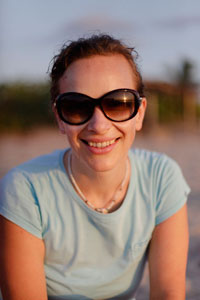
1.
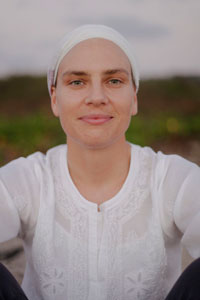
2.
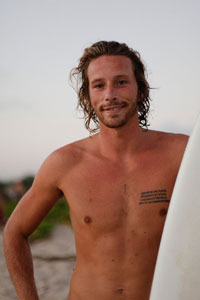
3.

4.
|
|
PLAYA GUIONES
1. Simon Hirsh, 39 and Tamara Hirsh, 37 – Tourists
Simon and Tamara Hirsh pointed out that it wouldn’t hurt to have a lifeguard, but it is not necessary. They said a warning board would be good to make people aware of the possible danger in the ocean. People should be responsible and remind themselves.
2. Jana Rihova, 33, from Czech Republic, Spends Six Months Here, Surfer
Jana Rihova compares Costa Rican beaches with the ones in the United States. She appreciates the fact that there are no restrictive beach regulations here. She also emphasized that she personally doesn’t need a lifeguard and thinks the whole beach doesn’t have to be guarded. But, she says, a part of the beach could have one.
3. Etienne Lebrun, 26, Traveler from Canada
Etienne thinks it would be great to have one at one point in the main area of the beach for safe swimming. It would be good for the families. They wouldn’t have to be in the water with their kids all the time. It would be good for the surfers, too, because there are many beginners on this beach.
4. Adriana Vila, 33, Lives in Playa Guiones
Adriana Vila commented that it would be better for the families and children to have a lifeguard on the beach.
5. Leah Biesack, 22, Here for a Month
Agreeing on the necessity of a lifeguard on the beach, Leah Biesack mentioned that many people aren’t familiar with the beach. “The ocean is not fixed. It is always changing. It is good idea to have somebody supervising”, she said.
PLAYA PELADA
6. Mike Avant, 52, Part Time Living
Mike Avant mentioned about the lifeguards of Playa Dominical and how it cut the number of drowning, adding “as there are more tourists, it is probably a good idea”. He also said that having a lifeguard on the beach can be beneficial for people who live here and have businesses.
7. Samantha Raley, 43, Lives Here Half the Year
Raley pointed out the fact that there are more children in Playa Pelada and would be a good idea to have one. “Not in Guiones. It is more of a surfer beach”, she continued.
PLAYA SAMARA
8. Didier Castillo, 29, Surf Instructor
He commented that there should always be somebody around, who is certified. After mentioning that Samara doesn’t have that many strong waves, he added “the fact that the water is shallow doesn’t mean that we don’t need a lifeguard. Costa Rican beaches need to be watched by professional lifeguards. Even though I have experience in the ocean, I would be happy to have somebody who will take care of a situation.”
9. Charlie Foerster, C&C Surf School
Charlie Foerster emphasized the lack of experience with the waves that the visitors have. He also believes that it is a good idea to have one. He said, “maybe not every day of the year but for Christmas and Semana Santa.” He also added that businesses would be willing to pay for lifeguard stands.
10. Chris Foerster, Hotel Owner
He said that Playa Samara is one of the safest beaches with “no currents” and “hardly any waves”. He also added, “I would spend the money on police station and keep that. We need police more than lifeguards.” |
|
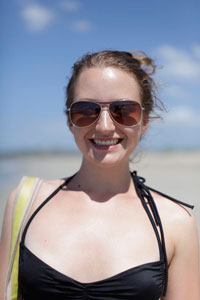
5.

6.
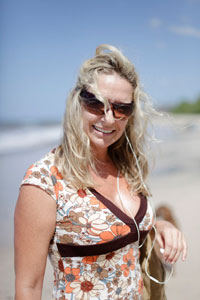
7.

8.

9. |
|

